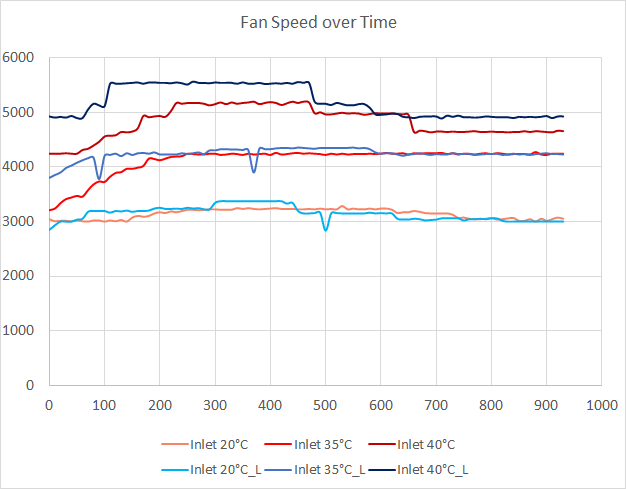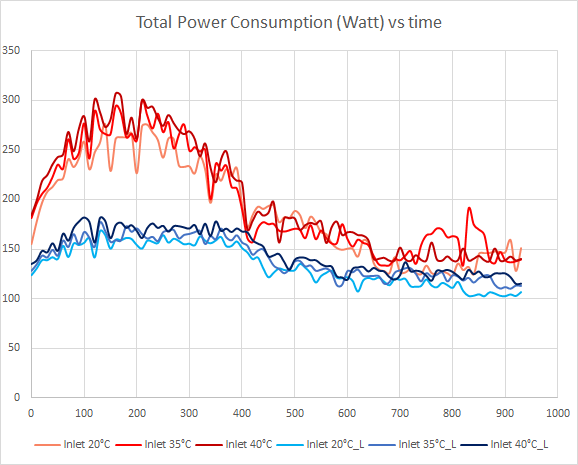Free Cooling: the Server Side of the Story
by Johan De Gelas on February 11, 2014 7:00 AM EST- Posted in
- Cloud Computing
- IT Computing
- Intel
- Xeon
- Ivy Bridge EP
- Supermicro
Fan Speed
How do these higher temperatures affect the fans?
It is clear that the fan speed algorithm takes more than just the CPU temperature and inlet temperature into account. There's definitely an ability to detect when a low power CPU with low tCase is used. As a result the fans are spinning faster with the 2650L than with the 2697 v2. That also means that the server has more headroom for the Xeon E5-2697 v2 than we first assumed based on the CPU temperature results. At higher inlet temperatures, the fans can still go a bit faster if necessary on the 2697, as the maximum fan RPM is 7000.
Power Measurements
The big question of course is how all this affects the power bill. It's no use saving on cooling if your server simply consumes a lot more power due to increased fan speeds (and potentially down time when replacing fans more frequently).
The difference in power consumed is not large between the three inlet temperatures. To make our measurements clear, we standarized on the measurements at 20°C as the baseline and created the following table:
| Xeon E5-2697 v2 | Xeon E5-2650L | |||||
|---|---|---|---|---|---|---|
| CPU load | Inlet 20°C | Inlet 35°C | Inlet 40°C | Inlet 20°C | Inlet 35°C | Inlet 40°C |
| 0-10 | 100% | 105% | 106% | 100% | 106% | 112% |
| 10-20 | 100% | 98% | 103% | 100% | 104% | 108% |
| 20-30 | 100% | 105% | 110% | 100% | 103% | 107% |
| 30-40 | 100% | 102% | 105% | 100% | 102% | 105% |
| 40-50 | 100% | 109% | 108% | 100% | 97% | 109% |
| 50-60 | 100% | 105% | 108% | 100% | 108% | 111% |
| 60-70 | 100% | 106% | 107% | 100% | 104% | 110% |
| 70-80 | 100% | 106% | 104% | 100% | 105% | 109% |
| 80-90 | N/A | N/A | N/A | 100% | 109% | 108% |
| Average | 105% | 107% | 103% | 109% | ||
As the fans work quite a bit harder to keep the 2650L below the low Tcase, they need a lot more power. We notice a 9% increase in power when the inlet temperature doubles. The increase is smaller with the Xeon E5, only 7%.
The most interesting conclusion is that raising the inlet temperature from 20 to 35°C results in almost no increase in power consumption (3-5%) on the server side, while the savings on cooling and ventilation can be substantial, around 40% or more.












48 Comments
View All Comments
bobbozzo - Tuesday, February 11, 2014 - link
"The main energy gobblers are the CRACs"Actually, the IT equipment (servers & networking) use more power than the cooling equipment.
ref: http://www.electronics-cooling.com/2010/12/energy-...
"The IT equipment usually consumes about 45-55% of the total electricity, and total cooling energy consumption is roughly 30-40% of the total energy use"
Thanks for the article though.
JohanAnandtech - Wednesday, February 12, 2014 - link
That is the whole point, isn't it? IT equipment uses power to be productive, everything else is supporting the IT equipment and thus overhead that you have to minimize. From the facility power, CRACs are the most important power gobblers.bobbozzo - Tuesday, February 11, 2014 - link
So, who is volunteering to work in a datacenter with 35-40C cool aisles and 40-45C hot aisles?Thud2 - Wednesday, February 12, 2014 - link
80,0000, that's sounds like a lot.CharonPDX - Monday, February 17, 2014 - link
See also Intel's long-term research into it, at their New Mexico data center: http://www.intel.com/content/www/us/en/data-center...puffpio - Tuesday, February 18, 2014 - link
On the first page you mention "The "single-tenant" data centers of Facebook, Google, Microsoft and Yahoo that use "free cooling" to its full potential are able to achieve an astonishing PUE of 1.15-1."This article says that Facebook has a achieved a PUE of 1.07 (https://www.facebook.com/note.php?note_id=10150148...
lwatcdr - Thursday, February 20, 2014 - link
So I wonder when Google will build a data center in say North Dakota. Combine the ample wind power with cold and it looks like a perfect place for a green data center.Kranthi Ranadheer - Monday, April 17, 2017 - link
Hi Guys,Does anyone by chance have a recorded data of Temperature and processor's speed in a server room? Or can someone give me the information about the high-end and low-end values measured in any of the server rooms respectively, considering the equation temperature v/s processor's speed?